We see them every day on the evening news during the weather forecast. A weather map is the most important tool in a meteorologist’s toolkit as it allows him or her to get a bird’s eye view of what’s happening in our atmosphere.
It’s not too difficult to interpret a weather map on your own, and being able to do so might allow you to forecast the weather by yourself without the help of the local weatherman. Let’s get started.
Learn How to Read a Surface Weather Analysis Map
Using the various tools available, the meteorologist can make a map showing the present weather, which also helps him or her to make better judgments on what the weather will be in the future. It’s called a surface weather analysis map, and it shows the positions of high and low-pressure systems, and the boundaries between warm and cold air called fronts.
Types of Weather Fronts
A weather front is a boundary separating two air masses of different density. These air masses can have large temperature contrasts over a short distance on either side of the front. If it sounds a bit militaristic, that’s because it is—meteorologists gave these boundaries this name for the similarity to a military unit moving across a battlefield. The air masses separated by a front will often have contrasting properties, there is usually a shift in wind direction across the front as well as changes in temperature and humidity.
Although not always the case, a majority of these fronts will be guided by the polar and subtropical jets, bringing a change in the weather as they pass. There are four main types of fronts—cold, warm, occluded and stationary fronts.
Cold Fronts

The cold front is usually the most active of the four major weather fronts. A cold front is defined as the leading edge of a cold air mass which is replacing and pushing up a warm air mass ahead of it. Because colder air is denser than warmer air, a cold front pushes the warmer air higher. As the warm air rises, it causes an area of low pressure along the cold front, as this occurs it can cause the formation of a narrow line of showers and thunderstorms when enough moisture is present (as shown below in the diagram from the Met Office UK).
Cold weather fronts generally move from northwest to southeast. When a cold front passes through temperatures can drop significantly. The air behind a cold front is noticeably colder and drier than the air ahead of it. In addition, they can bring about gusty, shifting winds.
Cold fronts on a weather map are depicted as a blue line with triangles on it, the triangles indicating the direction of its movement.
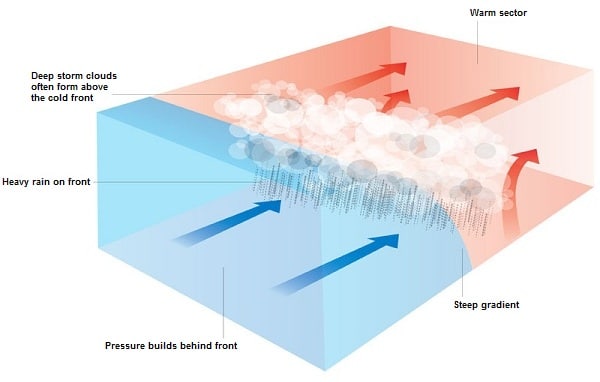
Image Credit: Met Office UK
Warm Fronts

Warm fronts are the opposite of cold fronts, where the warmer air mass, replaces the colder air mass. Warmer air is less dense, so unlike the cold front, it will lift over the top of the colder air as it moves through (see diagram). They typically move from southwest to northeast, and will bring about an increase in both temperature and humidity as the air behind the front is warmer and moister than the air ahead of it.
Warm fronts are red lines with semicircles, with those semicircles pointing in the direction of its movement.

Occluded Fronts

By definition, an occlusion in meteorology is where a cold front catches up to the warm front as they typically move faster than warm fronts. As a result, the warm air mass is forced up forming an occlusion. There are two types of occlusions, but they are both represented by the same symbol on a weather map. Occluded fronts are shown in purple with alternating triangles and semicircles on the side pointing to its direction of movement.
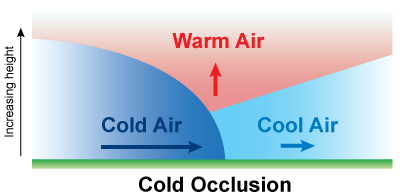
Image Credit: NOAA
In a cold occlusion, the most common, the air behind the occlusion is colder than the air out ahead in the warm front. The cold front overtakes the warm front and also undercuts the cooler air mass ahead of the warm front.
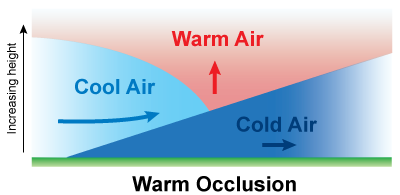
Image Credit: NOAA
A warm occlusion occurs when the air associated with the cold front behind the occluded front is actually warmer and less dense than the air mass in the warm front ahead of it. The warm air is pushed up as before, but now the colder more dense air mass in the warm front remains at the surface forcing the air mass associated with the less dense and warmer cold front up as well.
Stationary Fronts

As the name implies, stationary fronts are cold or warm fronts that are no longer moving as a balance exists between the cold and warm air masses on either side of the front, so that neither air mass can advance on the other.
The blue triangles of the cold front point towards the warmer air, and the red semicircles of the warm front towards the cold air. One of its most noticeable features is a marked temperature and/or wind direction change when crossing from one side of a stationary front to the other.
Less Common Symbols
The following symbols are much less common on basic weather maps. However, you might run into these on more advanced weather maps from the NOAA and other sources.
Dry Line

Most areas of the country don’t experience them often, but it’s important to mention the dry line. Dry lines are most commonly found in the High Plains states during the spring and early summer. You can think of these dry lines as a boundary marking the difference in humidity—warm, humid air on one side, and dry, hot air on the other. As the drier air behind dry lines lifts the moist air ahead of it, it can trigger the development of thunderstorms and sometimes severe tornadic thunderstorms along and ahead of the dry line.
Troughs

Troughs are not really fronts like the above symbols, but instead are elongated areas of lower atmospheric pressure (we’ll talk about highs and lows next). There’s no change in air mass across a trough, but you’ll notice changes in wind direction.
Troughs reflect the change in the atmospheric conditions in the upper atmosphere. As such, troughs can be areas where showers and thunderstorms can form.
Squall Line

On some advanced maps, meteorologists will place the squall line symbol to indicate the presence of an organized and severe line of thunderstorms. This line of thunderstorms generally forms along a front, and the storm then moves ahead of the front. They are usually seen ahead of cold fronts and dry lines, and can produce extended and fast-moving severe weather in the form of heavy rainfall, strong winds, hail, and lightning.
Understanding High and Low-Pressure Systems
Fronts aren’t the only things you see on a weather map. Meteorologists also like to plot areas of high and low pressure, and sometimes lines of equal pressure, called isobars. This information is just as important as the location of fronts, as it provides valuable clues for the day-to-day changes in our weather.
The earth's atmosphere exerts a pressure onto the surface which directly influences the movement of air. Areas of high and low pressure are formed by ascending and descending air masses. As air warms, it ascends, leading to low pressure on the surface. And as air cools, it descends leading to high pressure on the surface.
Most of the time, areas of low pressure develops unsettled weather with clouds and precipitation. Whereas, areas of high pressure tend to bring settled dryer weather with clear skies.
High-Pressure Systems

A high-pressure system is an area where the atmospheric pressure is higher at its center than the areas surrounding it. A blue H denotes a high-pressure system on a weather map. Air usually flows from areas of high pressure to areas of low pressure. From the point of highest pressure, this air moves in a clockwise (counter-clockwise in the Southern Hemisphere) or anticyclonic manner outward, causing the air above to sink. This is the reason why clouds and precipitation are rare under the influence of high pressure.
Low-Pressure Systems

A low-pressure system is an area where the atmospheric pressure is lower at its center than the areas surrounding it. A red L denotes a low-pressure system on a weather map. Air will tend to blow inward towards a low pressure in a counter-clockwise (clockwise in the Southern Hemisphere) or cyclonic manner causing air to rise at the point the air converges. As the air rises it cools, water vapor within it condenses forming clouds and often precipitation too. This is why low-pressure systems are usually associated with cloudy, rainy weather and even thunderstorms.
What Are Isobars?
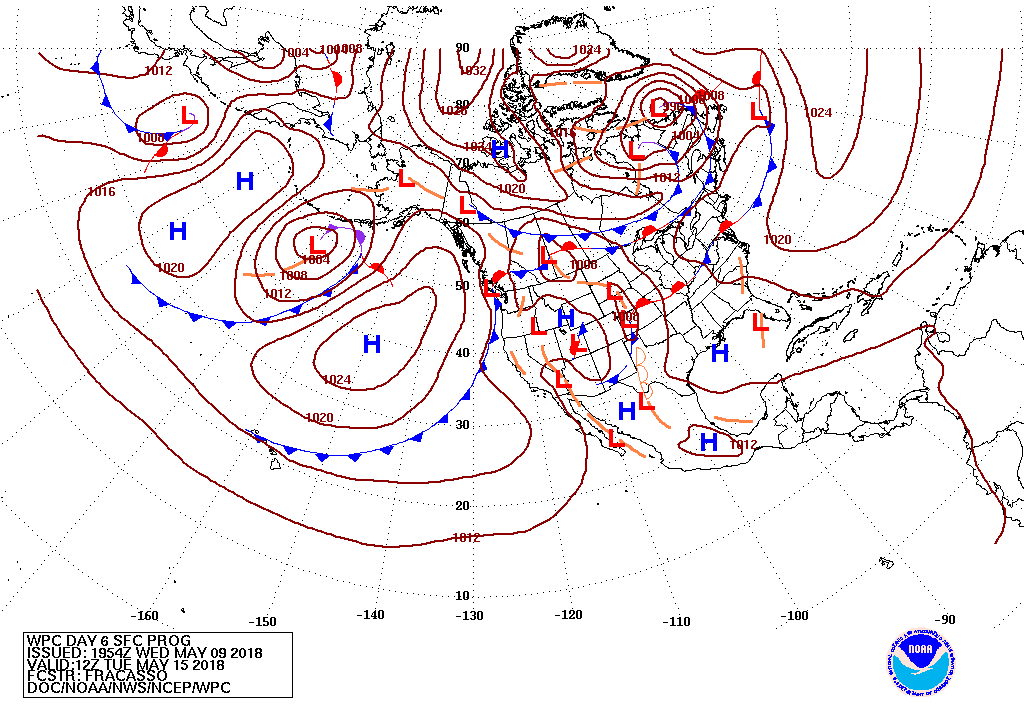
Image Credit: NOAA
You’ve most likely seen a weather map with curved lines on it in various circle-like shapes and sizes. These shapes are usually closer together around a low-pressure system, and further apart around areas of high pressure. These are called isobars—they connect points of equal pressure. Isobars are an important tool in identifying the locations of highs, lows, and even fronts. The numbers measure the atmospheric pressure in millibars.
Isobars also help to provide clues as to the wind direction and the speed of that moving air. When these lines are closer together, the pressure gradient is steeper causing air to move faster, while air moves slower when they’re further apart.
Other Symbols on a Weather Map
While a majority of weather maps will only have the above symbols, more advanced maps will also include some of the symbols listed in this image from the New Jersey Department of Environmental Protection.

There are a few things you will want to keep in mind. On American weather maps, temperatures are generally listed in Fahrenheit (this isn’t always the case, so be careful!), while maps from international sources will list temperatures in Celsius. The amount of cloud cover is indicated by the extent to which the center circle is filled in.
Wind speeds are always listed in knots, and the direction that the wind barbs come out of the center circle indicates the direction the wind is blowing from. If there is precipitation, you’ll see one of the symbols listed in the upper right of the graphic.
Another reporting method to study is what is called the weather station model on the bottom of the graphic. This is a standardized method used worldwide to show weather observations graphically.
For further reference, I have included a sample synoptic chart below which shows some of these symbols so you can see how it looks on a real weather map. See if you can read the map using the key as a guide!
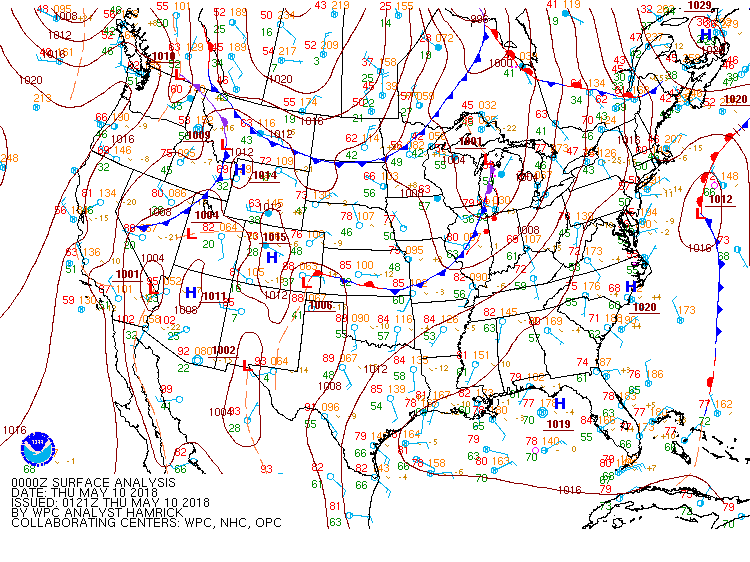
Image Credit: NOAA
Need More Help? Watch This Video
I hope you’ve learned quite a bit about how to read a weather map. To tie this all together, I recommend you watch the following video produced by The Weather Channel’s Ryan Davidson to help you understand some of the concepts better.

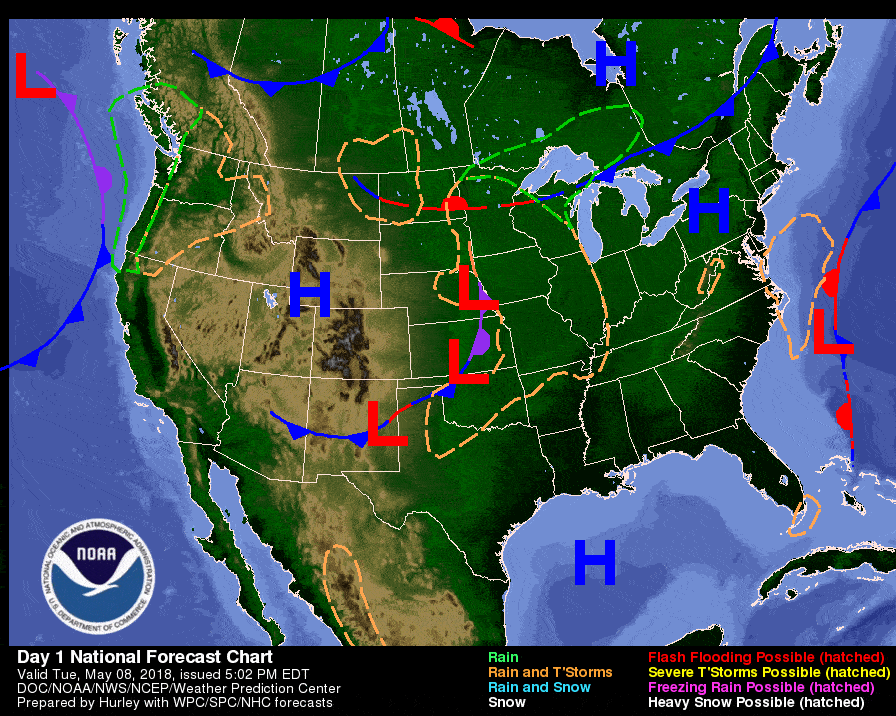
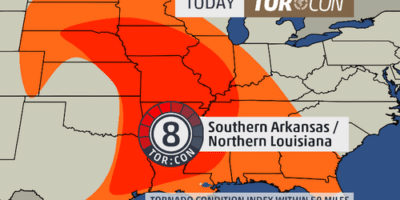



Nice article- it helped me study for Science Olympiad!!!
Thanks Ed, for this info on how to read a surface weather map. I refreshed what I learned in 1970-72? when
studiyng to become a flight dispachter. I think my daughter wants to learn little bit of this for home use.